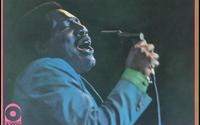In 1966, a year after he released his magnum opus, “Otis Blue,” and a year before his death, Otis Redding performed at Los Angeles’s famed Whisky a Go Go club—one of the first soul artists to play there. Although he didn’t truly become popular across America after these performances, they helped launch him to prominence after he received glowing reviews by the Los Angeles Times and was applauded by Bob Dylan. Redding wanted to make a live album to supplement the shows, in the style of James Brown, to try to extend his popularity outside his black audience base.
“We’re hoping that this be one of the greatest albums that ever come out. We need to eat!” Redding proclaimed in concert. Originally the live album was shelved by Redding’s record labels, Volt and Atco, because the sound quality was poor. The first volume of “Live at the Whiskey a Go Go” was issued the year after Otis Redding died. Several more volumes were released as single CDs or as collections as time went on. On Oct. 28, however, the complete recordings of Redding’s stay at the Whisky a Go Go were released, providing an incredible look into Redding’s performance.
Redding played seven sets over three nights about a week after he’d released “The Soul Album.” As a result, the shows tended to feature some repeats, with the biggest offender being his cover of The Rolling Stones’s “(I Can’t Get No) Satisfaction,” which he plays 10 times (although some of these are alternate versions of the song). Another reason for the repeats is that Redding said he wanted to make sure he got the songs he was playing right for the album, so he tried to get the perfect versions of his biggest songs, like “Respect,” “Security,” “Mr. Pitiful,” and “I Can’t Turn You Loose.” Redding played to the predominantly white crowd, trying to give them the best possible taste of his music in a single set (he only wanted people to stay for one set, as opposed to the whole day). Correspondingly, the only aspect of the recordings that sounds repetitive is the intros by Al “Brisco” Clark, who gives pretty much the same drawn-out introduction for Otis Redding each time.
The first day of the show, the audience doesn’t sound energized at all, but over the course of the next two days, the audience grows more involved, likely because of the positive reviews papers were giving Redding’s shows. The most interesting part of the performances is that few songs from Redding’s album, “The Soul Album,” (1966) are performed, save for his new single, “Good to Me,” which he introduces variously as “a song we just wrote” or “a song we made up just now.” This was likely a way for him to plug the single so that the audience would buy it, an effective method of self-advertisement in an era before music videos and widespread musical distribution via radio and internet. “Live At The Whisky A Go Go” shows Redding micromanaging much of the show, repeating songs, stage banter, and introductions just to nail the perfect take for the live album. Redding utilized every moment on stage to further his career, promoting his new single and covering hit songs by white artists like The Beatles—whatever he needed to get the audience to buy his records.
For all of Redding’s label’s concerns about the quality of the album being poor, the complete recordings suggest otherwise. Redding’s flow is spectacular,and his vocal energy is raw and charismatic. The song variety also helps. Redding and his band play around 18 different songs, some slow and some fast. The new single, “Good to Me,” often falls flat, but tracks like “Any Ole Way,” “Respect,” “Security,” “I Can’t Turn You Loose,” and “(I Can’t Get No) Satisfaction” hit the hardest. These are the songs that Redding executes perfectly. Any track where he could get people dancing seem to excite him.
By the end of the last show, Redding clearly felt that he had enough takes of the staple songs he was performing and decided to record some alternate material, covering songs like “A Hard Day’s Night” and “Papa’s Got A Brand New Bag.” When he cut the take early to say, “We don’t play James Brown; we play Otis Redding,” a fan responded with, “Who’s James Brown?” While Redding’s stint at the Whisky A Go Go doesn’t match Brown’s legendary performances at the Apollo, these recordings are good enough to evoke that reaction—especially as they give insight into one of soul’s most calculating minds.
Read more in Arts
'Little to Do with Anything' Provides Pointed FunRecommended Articles
-
W. Hoops Wins With Two Buzzer BeatersThe buzzer remains in critical condition after repeated beatings by the Harvard women's basketball team. Freshman point guard Jen Monti
-
Dylan's Message(With acknowledgements to Andrew Klein, Vinton Tompkins, and Paul Holleb for their special knowledge of the trade magazines, the Bible,
-
To Be The Very BestA LITTLE MORE than ten years ago, the two most beautiful and touching albums of the seventies were released almost
-
Governors Ball 2016: Mila's Saturday Sound BitesArts staff writer Mila Gauvin II offers quick takes on Jon Bellion, Misterwives, Purity Ring, and The Killers at Governors Ball 2016.
-
 The King of Soul in the Twenty-First Century: Otis Redding and The Dock of the Bay 50 Years Later
The King of Soul in the Twenty-First Century: Otis Redding and The Dock of the Bay 50 Years Later













